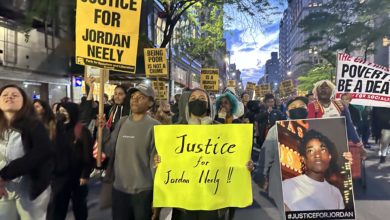 White racists burned down Wilmington’s only Black newspaper, November 1898. |
On Nov. 10, 1898, a white mob led by local rich, white leaders seized the reigns of government in the port city of Wilmington, North Carolina. The immediate result was the destruction of the local Black-owned newspaper office and the spread of mass terror in the African American community.
The long-term implications for Blacks in the city, state and the entire South proved devastating. The insurrection inspired political upheaval across North Carolina and Blacks lost the right to vote. It also led to the era of “Jim Crow” apartheid that lasted until the end of the 1960s.
More than 100 years later, in December 2005, the “Wilmington Race Riot Commission” submitted its 450-page report on the events leading up to, during and following the so-called “race riot” in Wilmington. Their report details the event that has been deliberately misconstrued for more than 100 years. The Commission was created by the North Carolina state legislature in 2000.
The official racist version of the attack describes it as “a response of white citizens to a corrupt municipal government unable to reduce crime or facilitate economic improvements for residents,” according to the report’s introduction. The facts showed otherwise.
The Wilmington incident was no “riot,” nor was it a spontaneous action. Rather, it was a premeditated power grab by white supremacist forces to seize control of the local government, pacify the politically active Black population, and reduce African Americans to second-class citizen status again following gains that they had made during the period of Reconstruction after the Civil War.
The reactionary violence came at a time when similar attacks on African American communities were launched in Atlanta, Tulsa, Oklahoma and Rosewood, Florida.
Rolling back gains by force
 African Americans tried to turn back counter-revolutionary tide. |
The defeat of the elected city government of Wilmington marked the end of all gains by Blacks during the period after the U.S. Civil War, called the Reconstruction Period. To understand the significance of the setback in 1898 in Wilmington, it is important to understand the Reconstruction Period.
After the Civil War, the triumphant North had to find a way to destroy the state power held by the Confederacy that had broken away and to reconfigure the Southern economy into the reunited United States.
Many Southern states did not want to accept the new reality of freed slaves and a destroyed plantation economy. In an attempt to maintain the racial status quo, states quickly enacted what they called “Black Codes.” The Codes served as a way to control and inhibit the freedom of ex-slaves. They controlled almost all aspects of life and prohibited African Americans from the freedoms that had been won.
But the radical wing of the Republican Party led a counterattack on the federal level. Using the congressional majority they gained in the election of 1866, the radical Republicans passed the Civil Rights Act of 1866 into law. The act declared that all people were citizens and were entitled to all the rights of citizenship.
The Republicans represented the interests of the victorious Northern bourgeoisie in the Civil War. They did not push for civil rights because they were benevolent and wanted Blacks to be equal. They did it because the old property relations of slavery had become an impediment to the expansion of industrial capital in the “free” North. The Northern and Midwestern bourgeoisie wanted political power and a free, mobile labor force.
During Reconstruction, the Freedman’s Bureau was created as part of the federal government. The Bureau helped establish a lifeline for newly freed Blacks, providing food, medicine and other services. It also established a system of public schools that laid the foundation for the first public school system for the entire South.
The South was also militarily occupied for several years by the U.S. Army. Tens of thousands of personnel were stationed in the Southern states to oversee the Reconstruction.
The federal Reconstruction Act of 1867 was meant to curtail violence and enforce the attempt by Congress to create a new social order in the Southern states. The act divided the South into five parts, each controlled by a different Northern general; ordered Southern states to elect new delegates and form new constitutions; required states to allow all males, African Americans included, to vote in the elections, while temporarily barring former supporters of the Confederacy from voting; and, most importantly, required all Southern states to guarantee equal rights to all citizens and to ratify the Fourteenth Amendment of the U.S. Constitution.
These factors allowed Blacks to gain political power in the former slave states. Black men served in both houses of the U.S. Congress and in state legislatures and local governments. It was the first time in U.S. history that Black people were able to be fully integrated into society.
These policies did not come without resistance. As progressive measures were being taken to advance African American equality, the vicious Ku Klux Klan was created in the late 1860s by ex-slave owners, southern businessmen and government officials. The KKK sowed terror among Blacks, torturing and lynching tens of thousands of African Americans.
Reconstruction was ultimately defeated by the Hayes-Tilden compromise of 1877. After an electoral tie in the presidential election between the Republican Rutherford B. Hayes and the Democrat Samuel Tilden, a deal was struck within the ruling class to allow the Republican Hayes to take the presidency under an agreement to remove Northern troops from the South. This détente between the southern and northern ruling class was a disaster for Blacks, leading to the erosion of all of their gains. State governments quickly began to pass Jim Crow laws. Segregation later was enshrined in federal law by the 1896 Supreme Court decision in Plessey v. Ferguson.
Coup d’etat against Black political power
Wilmington was North Carolina’s largest city after the Civil War. It had more Black residents than whites in the late 1800s. Even during the years immediately following the end of slavery, this was highly unusual. It also had a sizable population of Black artisans and other skilled-trade workers.
In the years following the Civil War, the white gentry and small businessmen merged in an attempt to regain control of Wilmington’s political apparatus. But the large Black population allowed the Republican Party to create a stronghold in the city. In Wilmington and across the state, “fusion” governments eventually arose. These were alliances between the Republicans and the Populists, a multiracial, class-based political movement.
These alliances helped the Black population of Wilmington retain the right to vote and other Reconstruction-era gains long after the end of the Reconstruction. In 1894 and 1896, the alliances led to a dramatic rise of Black political power in Wilmington after local elections.
By the 1898 elections, this coalition began to break apart, leading to a resurgence of the Democratic Party, the most racist and reactionary party in the state. The Democrats used a statewide speaking tour to inflame North Carolina’s white population with anti-Black sentiment. They also formed racist paramilitary groups to terrorize Blacks and whites who supported Republican or Populist candidates.
The Democrats’ efforts were supported by many of the high circulation newspapers, including the Charlotte Observer. It used racist editorial cartoons to depict Blacks as corrupt and bent on domination over whites.
In Wilmington, prominent Democratic leaders formed a group of nine white businessmen, dubbed the “Secret Nine,” who orchestrated the activities of two supremacist groups, the “Red Shirts” and the “White Government Union” clubs. Both groups regularly conducted armed marches through Black neighborhoods. They also planned the revolt in the city that would come after the election.
Before the Nov. 8 election, the white supremacist Democrats used an article written by Alex Manly, the editor of Wilmington’s only African American newspaper, to whip up racism and win votes. Manly’s controversial article challenged claims by whites regarding interracial sexual relationships. He wrote the piece in response to editorials in white-owned papers about Black men lusting after white women.
The election came and went without violence. Democrats won easily by stuffing ballot boxes and intimidating Black voters. But the racists were not appeased. They wanted a complete reversal of the Black population’s post-Civil War gains.
The day after the election, local wealthy white leaders held a large meeting. The meeting was used to stir greater anti-Black sentiment and prepare for the coming attack. At the meeting, resolutions called the “White Declaration of Independence” were drafted against Black citizens. The declaration, steeped in racism, read: “Believing that the Constitution of the United States contemplated a government to be carried on by an enlightened people; believing that its framers did not anticipate the enfranchisement of an ignorant population of African origin … We, the undersigned citizens of the city of Wilmington and county of New Hanover, do hereby declare that we will no longer be ruled, and will never again be ruled, by men of African origin.”
Another resolution demanded that Alex Manly must leave town. The white group presented their demands to the leading Black political and business leaders, known as the Committee of Colored Citizens. The CCC did not respond. On Nov. 10, the white leaders led an insurrection against the Black community.
A mob of whites first marched to Alex Manly’s office and burned it down. Soon, 2,000 armed white paramilitaries roamed the streets, patrolling nearly every city block. Rifles and rapid-fire machine guns were discharged, and Blacks were killed and wounded throughout the day. Paramilitaries even forced Black clergymen to open their churches for inspection, claiming they were looking for military arsenals that did not exist. It is not clear how many Black people died that day, but estimates run as high as more than 100. There were no white fatalities.
Meanwhile, white Democrat party leaders proceeded to City Hall, where the mayor and city council were meeting. These Democrats, many of whom were instrumental in launching the insurrection, forced all sitting government officials to resign and replaced them with their allies. All Black municipal employees were fired.
The coup d’etat was complete. Wilmington’s elected officeholders were replaced by white supremacists.
More than a footnote of history
Following the Wilmington insurrection, no state investigation took place. The federal investigation was closed in 1900 with no indictments issued. The newly elected Democratic legislature in North Carolina, helped by the new Democratic majority in Wilmington, immediately enacted the literacy test and poll tax. These laws, and others, disenfranchised the Black population and cemented Jim Crow in North Carolina.
It should not have taken a century for this historic crime to be recognized. The Wilmington Commission report is a long overdue step toward recognizing the true basis of racist apartheid in the Jim Crow South. It is the result of the determined efforts of anti-racist organizers in Wilmington and throughout the state. The city’s experience offers one of the most instructive cases in racist violence and intimidation.
But the Commission alone does not go far enough. Material compensation is long overdue for the African American population whose ancestors were enslaved, lynched and terrorized at the hands of white racists in places like Wilmington.
That would be part of a comprehensive reparations plan paid for from the wealth of the biggest U.S. banks and corporations designed to compensate the African American nation for centuries of slavery and racist oppression.
Articles may be reprinted with credit to Socialism and Liberation magazine.





